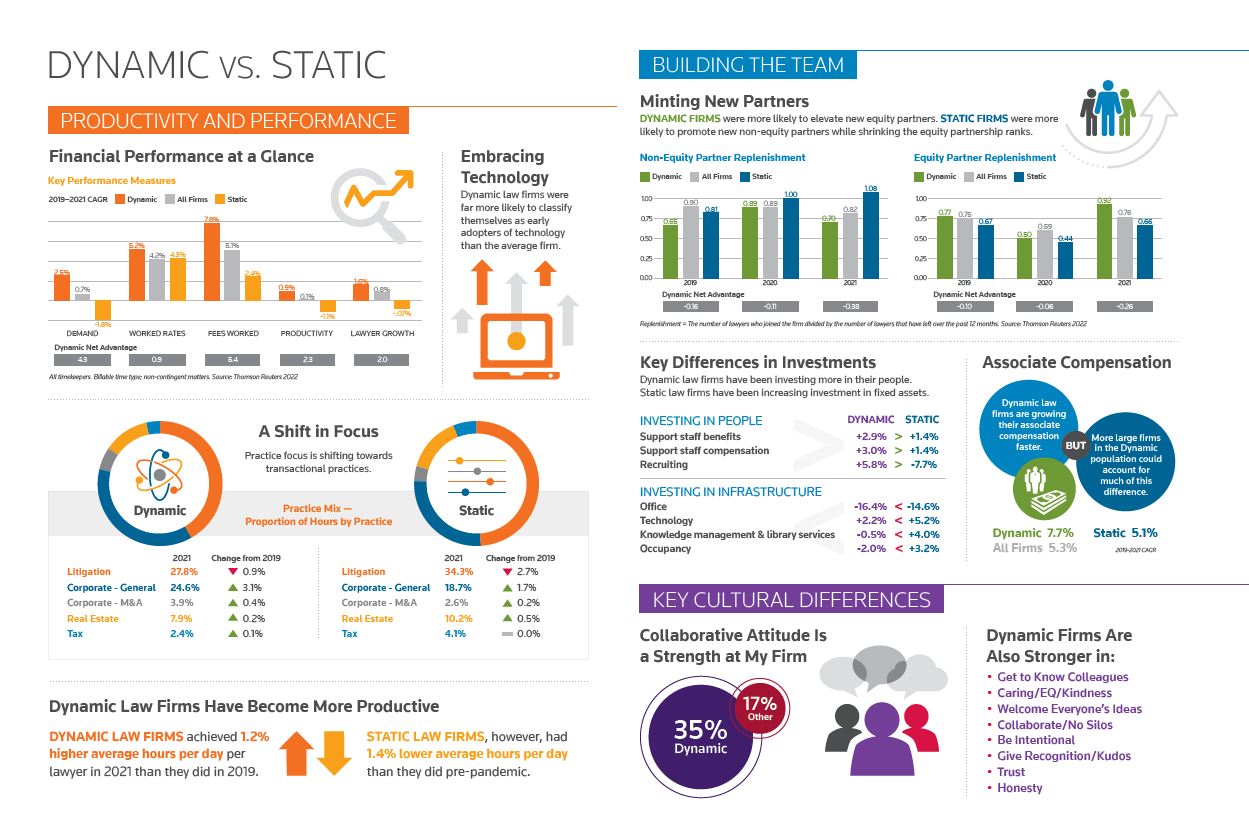● Investment in People
● Collaborative Culture
● Willingness to Embrace Change
Law firms love to know what drives success among their peers. Ever creatures of evidence and precedent, law firms and their leaders look for examples of strategies and tactics with track records that point to positive results to emulate.
For the past two years, law firms of all stripes have seen levels of success many believed were relics of the past. But even after two years where the average law firm posted profit growth figures that more closely resemble those seen prior to 2007, some firms have still shown an ability to rise to the top.
The 2022 Dynamic Law Firms Report from the Thomson Reuters Institute continues a years-long series of surveys and analyses that identifies market-leading firms in terms of growth in revenue per lawyer, overall firm profits and average firm profit margin, then digs deeper into these firms to determine what sets those market leaders apart, both quantitively and qualitatively.
This year’s report is somewhat unique, however. Prior versions of the report relied on redefined populations of firms that were determined based on the most recent year-end results. Rather than redefining which law firms are Dynamic firms based upon year-end 2021 financial results, this latest report follows a population originally identified at the end of 2019. The circumstances of the past two years provide a unique opportunity to examine whether the factors that led to those firms’ success prior to 2020 were the right factors for their time, or whether they helped create firms with more resiliency and sustainability.
The findings of the report show many of the steps that Dynamic law firms were taking prior to the pandemic also helped to position them for a higher level of success, even in a surging legal market.

First, Dynamic firms have been investing more heavily in their people. Profit per equity partner (PPEP) payments have been higher and have shown strong growth at these Dynamic firms. This is unsurprising given that Dynamic firms have also led the market in growth for both overall demand for legal services and worked rates. The strong revenue growth that resulted – balanced against carefully managed overhead expenses – has created a formula for strong firm profit growth. These profits have been parceled out not only among equity partners, but also among associates in the form of rising associate compensation. Dynamic firms are also investing more in people in the form of recruiting as well as salaries and benefits for support staff.
Another key factor in Dynamic firms’ success has been a lower-than-average turnover percentage for both associates and equity partners. This is a bit surprising, given the dramatic uptick in lateral talent hiring over the past year. Dynamic firms have been able to hold onto more of the attorneys who bring in the business, as well as those who tend to create the highest profit margins when completing the work.
The culture factor
Culture within Dynamic firms is yet another key reason why these firms are successful, and that is coming directly from the lawyers themselves. Stand-out lawyers – those identified by clients as top performers – within Dynamic firms were more likely to cite their firms as promoting collaborative cultures, embracing change and adopting practices like alternative fee arrangements more readily than their peers. Lawyers at Dynamic firms were also more likely to self-identify as early adopters or even innovators in technology.
This combination of higher investment in people and a more engaging culture has resulted in law firms where lawyers want to stay and where market-leading growth is part of the reward.
Dynamic law firms maintain higher overhead spending than the average law firm in tech and library categories, but Static firms have significantly invested in their firm, especially in technology and knowledge management and library services.
On the other hand, Static law firms – those firms that struggled to find growth in key metrics or in some cases even saw contraction – also experienced strong PPEP growth, but for much different reasons.
First, Static firms did not do as well in growing the overall pie for the firm. Average worked rate growth for Static firms actually trailed the overall market average rate growth. Static firms made up for some of this shortfall with higher-than-average realization against their rates, but this was tempered by a contraction in overall demand. Part of the demand contraction may be due to the fact that Static firms tend to have a higher proportion of their work matters coming from litigation, a practice area that has been slow to recover in the post-pandemic environment. As the report details, however, even adjusting for this divergence in practice proportion wouldn’t do much to help Static firms catch their Dynamic counterparts.
Static firms were also more likely to invest in fixed assets for the firm. Growth in occupancy, technology and knowledge management/library expenses at Static firms outpaced Dynamic firms, in some cases by wide margins. Much of this investment may be necessary attempts to catch up in areas where these firms have historically lagged, but the end result is less of the firms’ spoils to share among associates and staff, leaving Static firms lagging in these areas.
While growth in PPEP payments for Static firms actually outpaced Dynamic firms, it was not enough to overcome the advantage Dynamic firms had in terms of actual dollars paid out. Further, much of Static firms’ PPEP growth was due to those firms decreasing the number of equity partners receiving these payments, as demonstrated in the report’s analysis of replenishment statistics between the populations of firms.
It may be unlikely that any law firm falls squarely into the Dynamic or Static law firm camp on every single metric, as firms evaluate where they stand relative to the market on key strategic considerations. Still, the “2022 Dynamic Law Firms Report” provides a useful road map for law firms, highlighting both behaviors to model and potential pitfalls to avoid.






